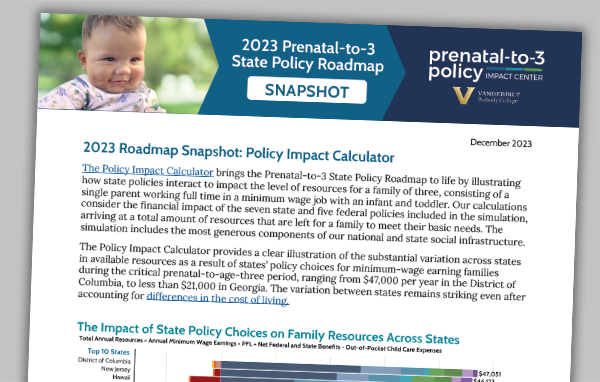What do you do if your toddler’s child care just disappears? Maybe the teacher left to take a better-paying, less messy job in retail. The child care center remains open, but with your child’s classroom dark and empty, you can’t make it to work. For many, this situation would lead to a reprimand at work—or even getting fired.
America’s child care crisis limits families’ access to affordable, high-quality care. State subsidy programs have the potential to support children, families, child care programs, and state economies, but only if policymakers consider the reality of the child care industry as a system of balanced parts.
This four-part blog series explores how state policy levers can make a huge difference, as well as the creative ways that states are finding sustainable funding. We dig into the surprising ways that supply and demand are off balance and artificially constrained, as well as solutions.
A Market Failure and Its Impact
Affordable, high-quality child care is an important resource for communities. Affordable care allows parents to work, reducing material hardship. Without reliable access to child care, parents miss work, turn down promotions, and may even leave the workforce entirely, costing the national economy $122 billion each year.
But not just any child care will do. High-quality care provides nurturing and responsive environments that keep children safe. Good care provides early learning opportunities that promote healthy brain and body development, laying the foundation for later learning.
But the cost of care gets in the way. High-quality child care—the kind that supports healthy development—is very expensive. For most families in the United States, any child care is already unaffordable, with care for one child ranging from 8 percent to almost 20 percent of a family’s income depending on where they live.
Yet early childhood education is among the lowest paid occupations in the country, typically well below a living wage. Low pay and lack of benefits leads to major challenges with hiring and retaining educators at a level needed to operate at full capacity.
Child care programs operate on paper-thin margins and cannot afford to raise wages without raising tuition. So, families cannot afford to pay for quality child care, and child care programs cannot afford to provide it. This market failure limits access to quality care for everyone.
The Promise—and Shortcomings—of Child Care Subsidies
Subsidy programs provide financial assistance to make child care more affordable for low-income families with parents who work or participate in education or training programs. The U.S. Department of Health and Human Services’ most recent analysis of eligibility and subsidy receipt shows a concerning trend of significant need but little help. In 2019, 8.7 million children were eligible to receive subsidies under state rules, but only 2 million children actually received those subsidies—an access rate of merely 23 percent. In many states, the proportion of eligible children served is much lower.
Child care subsidies have potential as a powerful tool for states. Subsidies can simultaneously expand access to high-quality care for children, raise the economic resources of working families, and stabilize the child care industry. In most states, however, subsidy programs fall short, with funding constraints and policies that restrict both supply and demand for subsidized slots. These market restrictions limit child care subsidies’ impact on the market.
Supply, Demand, and Equilibrium in the Child Care Market
Supply and demand refer to the relationship between the availability of a product or service (supply) and the desire or need for it among consumers (demand). This fundamental economic concept helps explain how the availability of a product affects its price, as well as consumer and producer behavior. When supply and demand are balanced, a market is in equilibrium.
In the child care industry, demand for child care is high, and supply is limited, but prices cannot rise further because the cost already exceeds what many families can pay. Unlike many other goods, however, child care is not a luxury that families can opt out of; when child care becomes unaffordable, parents may have to choose lower-quality care or leave the workforce entirely.
With child care subsidies, state governments can intervene in the open child care market. Through strategic subsidy reform that considers the industry as a system, states can make policy choices that increase the supply of subsidized child care and shift more families into the subsidy system (increasing demand for subsidized slots), all while ensuring that quality remains high.
But wait! If only a portion of eligible families currently access subsidies, shouldn’t demand for subsidies already be high? Well, as we will see in the third post in this 4-part series, increasing demand further can have major benefits.
Funding First, Then Policy Changes to Support System Stabilization
With sufficient investment and thoughtful policy choices, a state’s child care subsidy system has the potential to function as a stabilizing force for the entire industry, supporting families, child care businesses, and the state economy.
Achieving these outcomes, however, requires ongoing state investment. Many states have used temporary pandemic funds to pull levers that increase subsidy supply, demand, or both. But as federal funds begin to expire—and federal efforts to increase permanent funding have not succeeded—states need to identify sustainable funding streams to support lasting stabilization.
On August 11, the next post in this series will share how reimbursement rates play an important role in ensuring sufficient child care supply. The third post will tackle family demand and administrative barriers to uptake, focusing on state policy choices that can work with supply levers to promote a stable child care industry. The final post will talk about these policy levers’ impact on families and what the child care industry looks like across different states that have tried different approaches.
Don’t miss a single post in this series! Sign up to receive our emails, and be sure to check the option to receive announcements about new blog posts.



